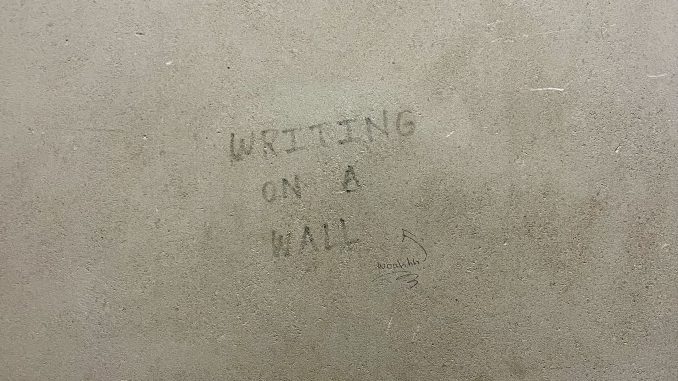
During my freshman year, I spent a lot of time in Myrin Library. Every day, I
would go up the stairs and look at the words written on the wall of the stairwell: Writing
on a wall. Although this vandalism was simply stating the obvious, it amused me and
became somewhat of a routine to read it every day on my way to study or go to CIE class
on the second floor. Now, as a junior, the writing on the wall of Myrin has faded,
whether due to wear or intentional scrubbing over the years. Regardless, this small piece
of graffiti stays fresh in my mind. I often wonder who the artist was, how they came up
with such a genius statement, and where they are now.
Across the campus, words and images are carved into desks, sharpied onto
bathroom stalls, written inside dorm furniture, and left on rocks around the grounds.
More often than not, they are vulgar and childish, but at times, they capture how an
individual was feeling at that point and time that they etched something onto the wall.
I’ve seen confessions of love, cries of sorrow, and political memos. Other times, it’s a
vote for preferences on female body parts, to put it politely.
Inside dorm rooms, students often etch their name and their year as a way of
making their mark on that particular space. In my freshman year, my roommate and I
found someone else’s name on the ceiling from the previous year. At the end of the year,
we carved our names inside the closets. This year, I found a previous student’s name
carved inside my desk. This form of ‘graffiti’ is a tradition; it is a way of leaving a piece
of our lives behind, even when they are relentlessly pushing us forward.
Other times, it is territorial, like the carving of a Greek organization’s logo in
study rooms. This is a way of showing one’s loyalty to a particular group. Many of the
Greek orgs have been at Ursinus for generations, so graffitiing their letters could be a
way of representing their legacy.
When you notice something carved into a study room wall or on your desk,
wonder who has sat in that seat before you; they also were likely stressed about their
classes, wondering where life would take them after college. The graffiti around the
campus marks the passage of time and the individuals who have walked the same paths
we walk now. When we leave this place, what of ourselves will be left behind?
Email cltracy@ursinus.edu with any graffiti you see around campus
